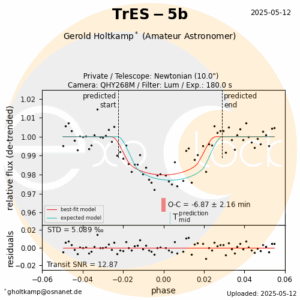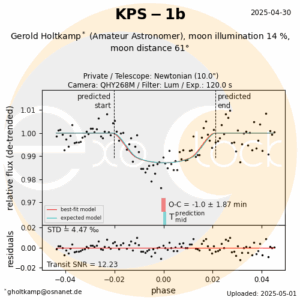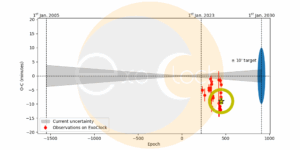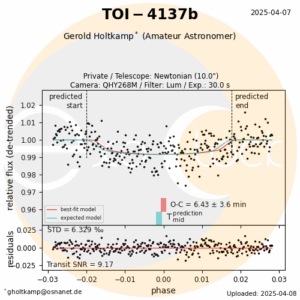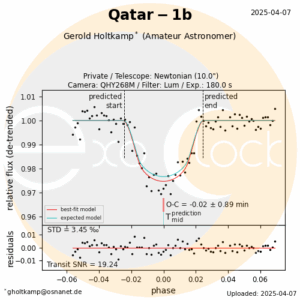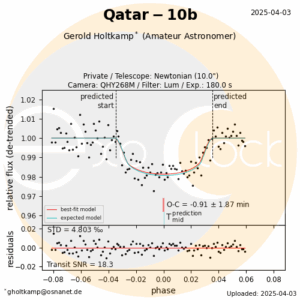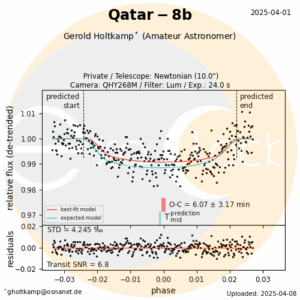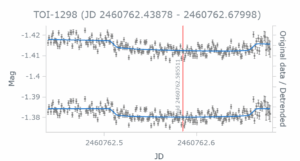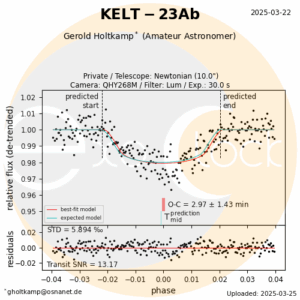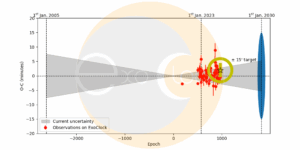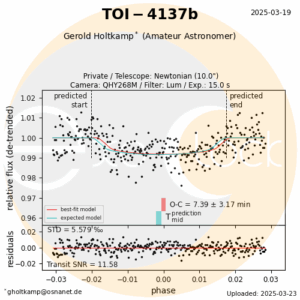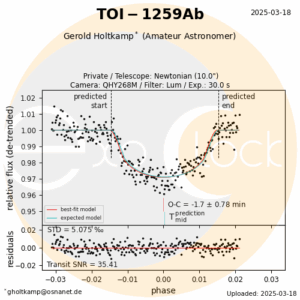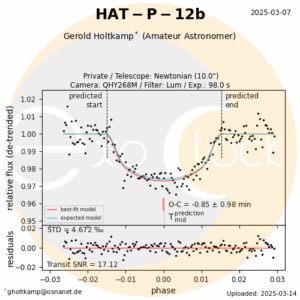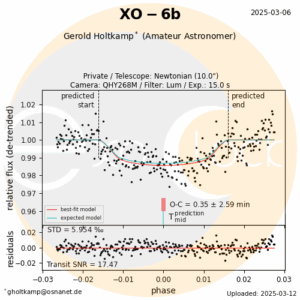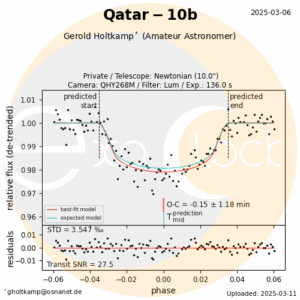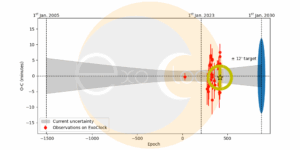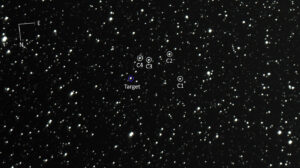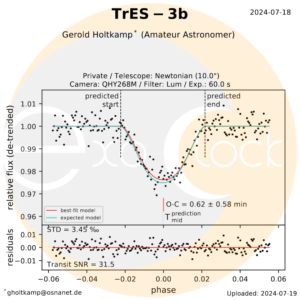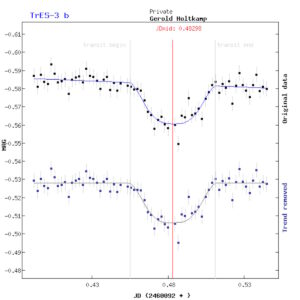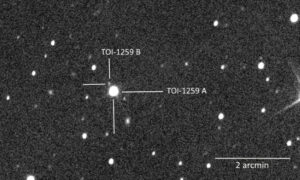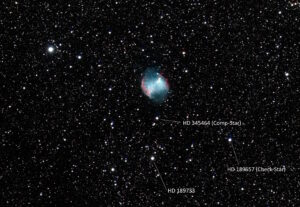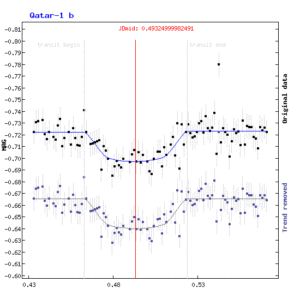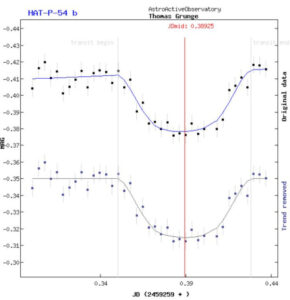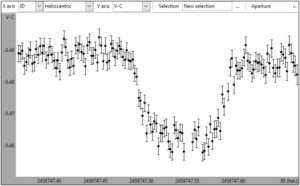
Exoplanets are planets that orbit other stars outside our solar system. Their discovery and research are of great importance. Amateurs can contribute to the study of exoplanets. For example, they can provide supplementary data by measuring the so-called transit light curves, in which the parent star is somewhat obscured by the planet moving in front of it, or by frequently determining the brightness and possible variability of the parent star. These data are used when measurements are to be carried out with extremely expensive telescopes, partly in space, which are previously dependent on certain parameters, e.g. precise timing.
To provide a better overview of the exoplanets observed by kosmos-os, we have created a map of the starry sky with the positions of the exoplanets and a list of the exoplanets in alphabetical order for you.
From August 17, 2025, due to the now large number of measurements, our transit light curve measurements of exoplanets will mostly no longer be presented in individual posts on our homepage. However, these measurements can be viewed in publicly accessible databases . For particularly interesting objects, still an own article will appear on our homepage.
- Reproducibility of transit light curves for the detection of exoplanetsThe transit light curves of five exoplanets are evaluated for their reproducibility. The parameters examined are the indirectly measured radius of the respective planet and the temporal center of the transit. After a detailed treatment of the individual exoplanets, a summary of the measurements shows that the respective planetary radius was measured reproducibly in 10 of 12 measurements.
- Measurement of the transit light curve of the exoplanet TrES-5b on May 11/12, 2025The exoplanet and its parent star are located in the constellation Cygnus, on the border with Cepheus. The measurements were taken from May 11, 2025, 10:13 PM UTC to May 12, 2025, 1:57 AM UTC in Osnabrück, Sonnenhügel. The moon was 99% illuminated but 104° away, so it could not shine into the telescope. It rose on May 11, 2025, at 6:22 PM UTC and set on May 12, 2025, at 3:00 AM UTC.
- Measurement of the transit light curve of the exoplanet KPS-1b on April 30/May 1, 2025The exoplanet and its parent star are located in the constellation Ursa Major. The measurements were taken from April 30, 2025, at 9:11 p.m. UTC to May 1, 2025, at 12:49 a.m. UTC in Osnabrück, Sonnenhügel. The Moon was 14% illuminated and 61° distant. It rose at 4:55 a.m. UTC on April 30, 2025, and set at 11:26 p.m. UTC, but its dim illumination was not yet disturbing.
- Measurement of the transit light curve of the exoplanet TOI-1811b on April 27/28, 2025The exoplanet and its parent star are located in the constellation Coma Berenices. The measurements were taken from 23:00 UTC on April 27, 2025, to 2:54 UTC on April 28, 2025, in Osnabrück, Sonnenhügel. The Moon was illuminated at 0.2% and therefore not obstructive.
- Measurement of the transit light curve of the exoplanet TOI-4137b on April 7/8, 2025The measurements were taken from 7:26 p.m. UTC on April 7, 2025, to 12:51 a.m. UTC on April 8, 2025, in Osnabrück, Sonnenhügel. The moon was 78% illuminated and 66° distant. It set at 3:24 a.m. UTC on April 8, 2025, and was therefore visible throughout the entire measurement period. It could therefore have shone into the telescope and potentially influenced the measurement accuracy.
- Transit light curve of the exoplanet Qatar-1b on June 6th/7th April 2025The measurements were taken from 10:07 p.m. UTC on April 6, 2025, to 2:24 a.m. UTC on April 7, 2025, in Osnabrück, Sonnenhügel. The moon was 70% illuminated and 93° distant. It set at 3:03 a.m. UTC on April 7, 2025, and was therefore in the sky for the entire measurement period. However, because it was 93° distant, it could not shine into the telescope.
- Measurement of the transit light curve of the exoplanet Qatar-10b on 2/3 April 2025The measurements were taken from 21:55 UTC on April 2, 2025, to 3:27 UTC on April 3, 2025, in Osnabrück, Sonnenhügel. The moon was 27% illuminated and 64° distant. It set on April 3, 2025, at 0:15 UTC.
- Measurement of the transit light curve of the exoplanet Qatar-8b on March 31/April 1, 2025The measurements were taken from 9:26 p.m. UTC on March 31, 2025, to 3:06 a.m. UTC on April 1, 2025, in Osnabrück, Sonnenhügel. The moon was 10% illuminated and 78° distant. It set on March 22, 2025, at 10:30 p.m. UTC. It was therefore not relevant for the measurement.
- Measurement of the transit light curve of the exoplanet TOI-1298b on March 27/28, 2025The measurements were taken from 22:32 UTC on March 27, 2025, to 4:27 UTC on March 28, 2025, in Osnabrück, Sonnenhügel. The moon was illuminated at 3% and 101° away. It was therefore not relevant for the measurement.
- Measurement of the transit light curve of the exoplanet KELT-23Ab on March 21/22, 2025The measurements were taken from 10:21 PM UTC on March 21, 2025, to 2:37 AM UTC on March 22, 2025, in Osnabrück, Sonnenhügel. The moon was 55% illuminated and 98° distant. It rose at 3:30 AM UTC on March 22, 2025. It was therefore not relevant for the measurement.
- Measurement of the transit light curve of the exoplanet TOI-1516b on March 20/21, 2025The measurements were taken from 10:39 PM UTC on March 20, 2025, to 3:34 AM UTC on March 21, 2025, in Osnabrück, Sonnenhügel. The moon was 64% illuminated and 115° distant. It rose at approximately 1:15 AM UTC on March 21, 2025, but only reached a maximum altitude of 9° above the horizon. It was therefore of little relevance for the measurement.
- Measurement of the transit light curve of the exoplanet TOI-4137b on March 19/20, 2025The measurements were taken from 7:19 PM UTC on March 19, 2025, to 12:39 AM UTC on March 20, 2025, in Osnabrück, Sonnenhügel. The moon was 74% illuminated and 133° distant. It rose at approximately 12:15 AM UTC on March 20, 2025, and was therefore hardly relevant for the measurement.
- Measurement of the transit light curve of the exoplanet TOI-1259Ab on March 18, 2025The measurements were taken from 12:14 a.m. UTC on March 18, 2025, to 4:32 a.m. UTC on March 18, 2025, in Osnabrück, Sonnenhügel. The Moon was 87% illuminated and 103° distant. It set around 6:05 a.m. UTC. Sunrise was already around 5:30 a.m. UTC, which is why measurements could only be taken until about half an hour after the end of the transit.
- Measurement of the transit light curve of the exoplanet HAT-P-12b on March 7/8, 2025The measurements were taken from 9:42 PM UTC on March 7, 2025, to 2:00 AM UTC on March 8, 2025, in Osnabrück, Sonnenhügel. The moon was 64% illuminated and 87° distant. It set around 4:25 AM UTC.
- Measurement of the transit light curve of the exoplanet XO-6b on March 6/7, 2025The measurements were taken from 9:27 PM UTC on March 6, 2025, to 2:20 AM UTC on March 7, 2025, in Osnabrück, Sonnenhügel. The moon was 54% illuminated and 46° distant. It set around 2:15 AM UTC.
- Measurement of the transit light curve of the exoplanet Qatar-10b on March 5/6, 2025The measurements were taken from 11:28 PM UTC on March 5, 2025, to 4:11 AM UTC on March 6, 2025, in Osnabrück, Sonnenhügel. The moon was 43% illuminated and 80° distant. It set around 1:00 AM UTC.
- Measurement of the transit light curve of the exoplanet TOI-2154b on March 4/5, 2025The measurements were taken from 7:20 PM UTC on March 4, 2025, to 12:16 AM UTC on March 5, 2025, in Osnabrück, Sonnenhügel. The moon was 28% illuminated and 63° distant. It set at 12:20 AM UTC. During the measurement, some cirrus clouds passed through.
- Big, black, hot and with a short life expectancyThe measurement of the transit light curve of the exoplanet Wasp-12b is described. This exoplanet is special in many ways. The large number of existing transit light curves, including our own measurements, enables spectacular predictions about the lifespan of the exoplanet.
- Measurement of the transit light curve of the exoplanet TOI-2570 bThe measurement of the transit light curve of the exoplanet TOI-2570 b, which was only discovered in 2022, is described. The brightness of the parent star, which is located in a very dense field of stars, was determined in 148 images in relation to comparison stars. The result agrees very well with the data known so far.
- TrES-3b, HAT-P-18b, TOI-2154b and TOI-1251.01The measurements of the transit light curves of the exoplanets TrES-3b, HAT-P-18b, TOI-2154b as confirmed and TOI-1251.01 as unconfirmed exoplanet are described. Each of them has peculiarities that make it worthwhile to take a closer look at them.
- Measurement of the transit light curves of the exoplanets WASP-84b and KPS-1b on March 7 and 8, 2024The measurement of the transit light curves of the exoplanets WASP-84b and KPS-1b is described. The radius of the exoplanets is determined from the degree of “darkening” of the parent stars. The transit method makes this possible, although the two systems can only be observed as point sources of light.
- Measurement of the transit light curve of the exoplanet TOI 3952.01 on January 10, 2024The measurement of the transit light curve of the exoplanet TOI 3952.01, 1929 light years away, is described. It is a recently discovered exoplanet. The own measured data are compared with the few available literature values.
- Transit light curve of the exoplanet TOI-1259 A b on September 25th/26th, 2023The transit of the exoplanet TOI-1259 A b in front of its parent star, which is a component of a binary star system, is shown. The light curve recorded agrees well with the measurements of other authors. A detailed error analysis provides information on how to further improve this sensitive measurement method.
- Measurement of the Transit Lightcurve of Exoplanet TrES-3 bThe transit light curve of the exoplanet TrES-3 b was recorded and measured on May 27th and 28th 2023. The method used and the specific observation conditions are explained. The results are presented and discussed based on an evaluation in the international Exoplanet Transit Database (ETD). The own result is a contribution in the context of so-called citizen science for further exploration of exoplanets.
- "Just" discovered - Exoplanet TOI-1259 A bThe transit light curve of the exoplanet TOI-1259 A b, discovered just two years ago, was measured. The data determined agree well with literature values. It is a double star system, which is additionally interesting. The close position at the north celestial pole allows interesting further observations.
- "boundless vastness" @ HomeIn the constellation Draco you can find exoplanets that are particularly bright. They can therefore be easily photometrically analyzed with small apertures. The measurement of the transit light curve of the exoplanet Qatar-10b is described. It was discovered in 2019 and confirmed as such.
- The star HD189733 and its planet HD189733bUsing the star HD189733 and its exoplanet 189733b, it is shown that even with a relatively small instrument from an urban light-polluted area, interesting meaningful measurements of stellar rotation and planetary transit in front of its parent star can be carried out. In addition, the synopsis of the results of many amateur astronomers worldwide enables further insights.
- Exoplanet XO-2 N b at 27th February 2022Two sun-like stars (yellow dwarfs) orbit each other 486 light-years away in the constellation Lynx. Both stars, XO-2 N and XO-2 S, have a total of three exoplanets detected using the transit method. With amateur means, one of these exoplanets, XO-2 N b, could be detected on February 27, 2022 by a light curve.
- Hot Jupiter with an uncooled DSLRThe measurement of the light curve of the exoplanet Qatar-1 b with an uncooled DSLR camera is described. The challenge is to achieve a meaningful result despite the high noise.
- Light curve of the exoplanet HAT-P-54bThomas Grunge did not only take a picture in his garden, but a light curve of the exoplanet HAT-P-54b. This planet does not orbit around our sun, but around the star HAT-P-54, whose light has been on its way to us for 443 years. This planet can no longer be seen directly, but can only be detected when it passes in front of the star and slightly obscures the star's light.
- Detecting exoplanets with my own equipmentBy 2019, more than 4500 planets had already been detected in alien star systems. Can the detection also succeed with your own astronomical equipment?
- My first exoplanet measurementThe author's first own exoplanet measurement is described. It has only been possible to detect exolanets since a historically very short time. Even amateurs can now understand this leap in knowledge in astronomy.
